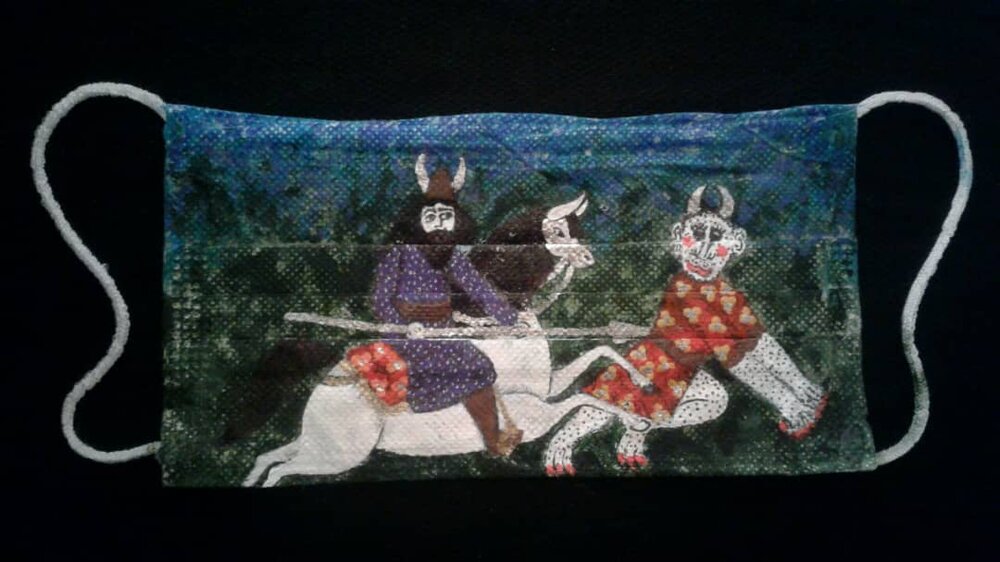TEHRAN – Ferdowsi’s masterpiece Shahnameh and its seven adventures have been the source of inspiration for Iranian graphic designer Yazdan Saadi’s new collection of paintings on face masks, which depict the mythical Iranian hero Rustam fighting coronavirus monsters.
“I have actually been inspired by the Shahnameh. The reason is that book is one of the oldest and biggest sources of epic Persian stories in the world, and for Iranians it is the best source filled with stories and wisdom for living,” Saadi told the Tehran Times in an interview on Tuesday.
“The idea is derived from the Shahnameh but it is not the story of Rustam and Sohrab or Rustam and Esfandiar. All the masks show different stories inspired by the last story of ‘The Seven Adventures of Rustam’. They tell stories of the fight of Rustam with the white monster, however, the white monster is the coronavirus this time which appears in different shapes in each painting,” he explained.
“I have assumed that the dragon is the symbol of the new virus, which is coming from China into our country Iran, and that Rustam is fighting with it once with his bludgeon, once with a spear and once with a sword, and in all the battles, Rustam conquers it and is the winner,” he said.
“Actually in most stories, Rustam conquers the corona monsters. And even where he is fighting the female evil he is still the winner,” he remarked.
Saadi further noted that the works are all in small sizes and that he could not make long stories but he has tried to add different elements like shapes of buildings or trees in the background with different day and night times to make slight changes.
“Each work has its own story. For example, Zahhak is sitting instead of the coronavirus, and when Rustam is holding the snakes on the shoulders of Zahhak in his hands, two more snakes are coming out of Zahhak’s mouth, and it means whatever we try to conquer this new virus, it still comes out in other forms,” he added.
In Persian legend, Zahhak is the name of an Arab king who conquered and ruled over ancient Iran. The story is recounted in the Shahnameh. Kaveh is the hero in this particular story, who rescues his Kurdish people in Iran from Zahhak’s control.
“All these concepts and paintings are made based on the news I receive and hear every day,” Saadi said.
The other one is the fight of Rustam with a woman who is evil.
“In this story, we don’t see a battle in its real meaning; it is as if they both have the same power, also mentioning that overcoming the new virus is hard,” he said.
He explained that in simple words he has tried to say the new virus will not fade away in a short time and it needs more time and people still have to fight with it.
He also explained why he chose face masks for his new collection.
“In the process of my artistic career, this was not something unusual. I always pay great attention to the materials I use in my works. The idea was not strange for me. We didn’t have the habit to live with face masks and only doctors and craftsmen used them in their jobs, and this was a new thing added to our life, something to wear outdoors which was annoying at first,” he explained.
“Although I was in quarantine, I used to wear a face mask for shopping and it was something extra which we were not used to and of course, still not used to. Perhaps it is one way to tell the story of an additional outdoor wear we must wear in addition to our previous clothes,” he added.
“Although the new virus has captured and influenced our lifestyle, I decided to conquer the idea of wearing a face mask as I thought this must be a concept of battle and fighting,” he said.
“In our culture, we still do not have the habit of wearing a mask and not many are using face masks. Perhaps masks can protect us from the new virus, and these two ideas were combined in this new collection,” he said.
“I have displayed my works on my Instagram. The collection was seen on my Instagram and many liked the idea, and even some from other countries liked my paintings and shared them,” he remarked.
“A friend asked me to display my works at the Los Angeles branch of Seyhun Gallery, however, I would prefer to display my works in a gallery in Iran too, when there will be a chance,” he said.

Iranian graphic designer Yazdan Saadi wears one of his face mask painting.
Saadi further added that it has been over 4 months that he is in quarantine.
“I am the person who used to go to the coffee shops every day. I liked the idea sitting in the coffee shops and watch people and the quarantine was hard for me at first, but I produced three collections. And I still would like to continue the quarantine because I obtained good results and I could concentrate on large works,” he mentioned.
Asked about his suggestions to the youth during the pandemic, he said, “I also propose and suggest the youth to do what I have done myself. I am a positive person, though coronavirus has crippled our lives. I have not even had the chance to visit my family but I am looking at its other positive side, of course. Our type of living has changed and we will never get back to the past form of living.”
“We found out that we used to enjoy our life. We had a simple and easy life compared to the present time. But even after years that the new virus is controlled, we still cannot repeat our previous life and will have to experience a new type of living,” he noted.
“But, I think this is good. We should have done it before and this has been part of our present lives, to wash whatever we buy in the shops. This will remain in our lives. We are not the same persons and will not be the persons we were five months ago.
“The other thing is that we can help the environment with little changes. Mother Earth is breathing and there has been a big awareness. Man has entered a new era with coronavirus. He has become aware that he should think of many things. He should not think that everything will be the same but should anticipate and stop many things before he begins to do something.”
Asked about the artist’s duty during the pandemic, he said that he believes artists have no duty under any circumstances, however, some show reactions and some show no reaction, or show a delayed reaction.
“People found out that without art they cannot live and began to pay more attention to music and books, and musicians began to give online concerts for free.
“This helped us tolerate those hard days. I think one of the lessons for the public was that without art life is not possible and that artists, musicians and filmmakers helped us go through those days with less anxiety and less depression. Their imaginations flew away and we listened to good music and read good texts and spent those days in much better and easier ways,” he concluded.
TAGS


No comments:
Post a Comment